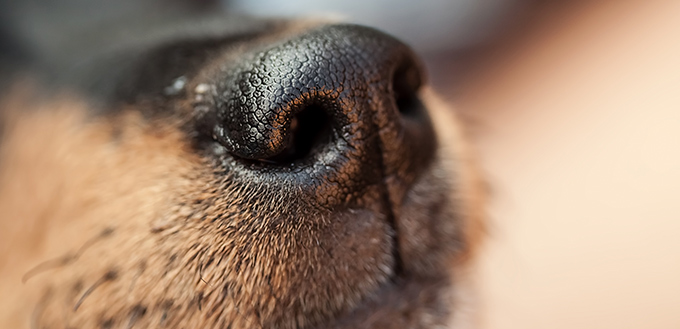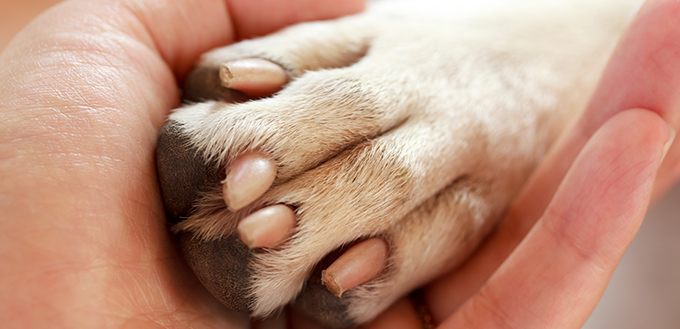As the term implies, canine hyperkeratosis is a condition whereby certain body parts of your dog grow substantially thicker than normal. The fibrous protein that makes up the outermost layer of the skin increases in number such that there is a progressive thickening of the skin. This abnormal epidermal tissue growth typically occurs in regions where you don’t normally see any hair growth such as the nose and the paw pads. If the thickening of the skin occurs in the nose it is called nasal hyperkeratosis. If it is the paw pads that are affected, then it is aptly termed paw pad hyperkeratosis or simply hairy dog feet.
Why Should I Be Concerned About My Dog Having Hyperkeratosis?
Thickened skin increases the distance between the dermal layer where the blood vessels and its nutrient supply is found and the outermost epidermal layer made up of thickened keratin. This essentially deprives the outermost layers of oxygen and moisture making it very hard, very dry, and often resembling that of a callous. This can lead to cracks in the skin, allowing pathogenic microorganisms to gain entry into the rest of the skin initiating an infection.
Both nasal and paw pad hyperkeratosis can be extremely uncomfortable, but more so of the latter type since the paw pads are what bear the whole weight of the dog. Since the keratin layer is super-thick, it compresses on the underlying structures of the skin, putting pressure on the nerve endings located in the dermal layer. That is why it can also be extremely painful for dogs.

What Causes Hyperkeratosis?
Hyperkeratosis in dogs can be brought about by the following.
- Genetic
Some breeds are shown to be genetically predisposed to canine hyperkeratosis compared to other breeds. For example, if the thickening of the nasal or paw pad keratin layer occurs within the 1st year of life of a Labrador retriever, Bedlington terrier, Dogues de Bordeaux, Golden retriever, and Irish terrier, there is a 100 percent chance that they carry the gene that codes for canine hyperkeratosis. The timing of the appearance of the clinical manifestations is crucial. Since the condition is an inherited trait, it should manifest early in a dog’s life. If it occurs later in life, then the most likely cause is not that of a genetic origin. There really isn’t much that you can do if the cause of hyperkeratosis is genetic since there’s no way you can rewrite the genetic code already embedded into every cell in your dog’s body.
- Leishmaniasis
Leishmania is a protozoon that can cause both cutaneous and visceral reactions in dogs. The parasite is transmitted by sandflies and causes skin reactions in 9 out of 10 dogs affected with Leishmaniasis. The good news is that hyperkeratosis in this case is a sign of another disease entity. Addressing the problem – the Leishmaniasis – should also help get rid of the hyperkeratosis.
- Canine distemper
Belonging to the class of viruses known a Morbilivirus which is closely related to the measles virus, canine distemper occurs mostly in non-immunized senior dogs as well as unvaccinated young puppies, although the virus can infect almost at any stage in a dog’s life. There is no cure for canine distemper since it can cause death in severely immunocompromised dogs in a matter of weeks. It has been shown that some strains of canine distemper produce abnormal thickening of the paw pads of dogs leading experts to call it the hard pad disease. Treating hyperkeratosis caused by canine distemper should only be secondary since there are more serious health issues that need to be addressed such as vomiting, diarrhea, seizures, and paralysis.
- Zinc responsive dermatosis
Zinc is an important mineral that plays a role in various physiologic processes in a dog’s body including the production of structural proteins, enzymes, and hormones as well as the regulation of the immune system and iodine metabolism. Because of its role in the formation of structural proteins, of which keratin is one of them, dogs that are deficient in zinc can also present with canine hyperkeratosis. Since the cause is nutrient-related, supplementation can readily address the issue.
- Pemphigus foliaceus
This is an autoimmune disorder whereby the cells of the immune system attacks its own cells leading to the loss of the ability of keratinocytes to adhere to the upper parts or layers of the epidermis. This produces blistering of the skin, but only when the skin is rubbed. It is a very common autoimmune disorder that affects not only dogs but cats as well. Diagnosis typically involves performing a biopsy and subjecting the tissue sample to morphological and histological analysis. Treating it will require the use of immunosuppressants. Unfortunately, using such agents can expose the dog to opportunistic infections because its immune system’s normal functioning has been effectively suppressed.
- Idiopathic
There are cases when the hyperkeratosis cannot be attributed to genetics or any other disease condition like the ones listed above. In such cases, as long as the presenting signs and symptoms are reflective of canine hyperkeratosis and that the cause cannot be determined with absolute certainty, the condition is called an idiopathic canine hyperkeratosis. This is typically found in older dogs that don’t have any of the above conditions.

How Do I Know My Dog has Hyperkeratosis?
So far we have been talking about hyperkeratosis in dogs and what typically causes this kind of disease. But how can you be sure that your dog really has hyperkeratosis and not some other abnormality in your dog’s nose, muzzle, and/or paw pads? We have listed below some of the more common signs and symptoms of canine hyperkeratosis. However, if you really want a more definitive answer to your question, you know that only your vet can give you peace of mind.
- Unable to walk in a rather straight line
- Possible limping while walking
- Obvious lameness
- Accumulation of scar tissue in either the nose or the paw pads or both
- Calloused nose or paws
- Progressive raised or crusted mounds
- Hardening or thickening of the skin surrounding the muzzle, nose, or paws
- Pain and swelling in the affected areas
- Excessive dryness of the affected skin
- Signs of irritation in the nose or paws
- Cracking or splitting of the skin of the nose and paws or its immediate surroundings
- Infection in the area surrounding the nose, nails, and paws
Do take note that if you see any of these signs, it doesn’t really automatically say that it is hyperkeratosis since it can mean other things. What you need to do is to have your veterinarian confirm it and help you determine its exact cause so you’ll have a much better chance at treating it.
What Treatment Options Does My Dog Have?
Based on what we have discussed so far about the possible causes of hyperkeratosis in dogs, it is clear that if the cause is genetic or even idiopathic in origin, there really isn’t a cure since either we cannot rewrite the dog’s genetic code or we cannot begin treating something that we don’t know the cause.
Treatment, in this case, therefore is more geared towards the alleviation or mitigation of the symptoms associated with the condition. Remember that symptomatic treatment is not a cure. It doesn’t address the problem itself. This is especially true for the genetic and idiopathic types of canine hyperkeratosis.
However, if the condition is brought about by canine distemper, Leishmaniasis, zinc responsive dermatosis, or even pemphigus foliaceus, then curing it is as simple as curing these causative pathologies. For instance, giving an antiparasitic agent to fight Leishmaniasis can also eliminate hyperkeratosis. Administering immunosuppressants in dogs with pemphigus foliaceus will also eliminate hyperkeratosis. But in the case of genetic hyperkeratosis, unfortunately, there isn’t any cure.
What you can do, however, is to manage the symptoms.
- Pain relief
Your veterinarian can recommend an appropriate analgesic for your dog. You should never experiment with OTC drugs since these may not be effective at all in alleviating the pain. In many cases, a topical application may be recommended to help hydrate the cracked and overly dry skin. This can also help soothe the skin and lessen the pain that your pooch experiences.
- Softening of the callouses
Veterinarians typically apply wet or moist dressings that are laced with aloe, mineral oil, or even petroleum jelly to help soften the calloused area of the skin. Some would also recommend soaking the dog’s feet in an emulsion of essential oils, sweet almond oil, vitamin E, and shea butter.
- Removal of hardened skin
If the skin is too thick to begin with, your veterinarian may have to ‘shave’ the excess thickness. Under no circumstances should you do this to your dog yourself.
- Manage secondary infections
If there are signs of infection, your vet will also order for the application of topical antibiotics, often in conjunction with wet or moist dressings.
Canine hyperkeratosis may not be a life-threatening condition. However, it can definitely make life more miserable for your pooch. Now that you know something about this condition, we’re optimistic you’re in a much better position to take care of such a condition.







